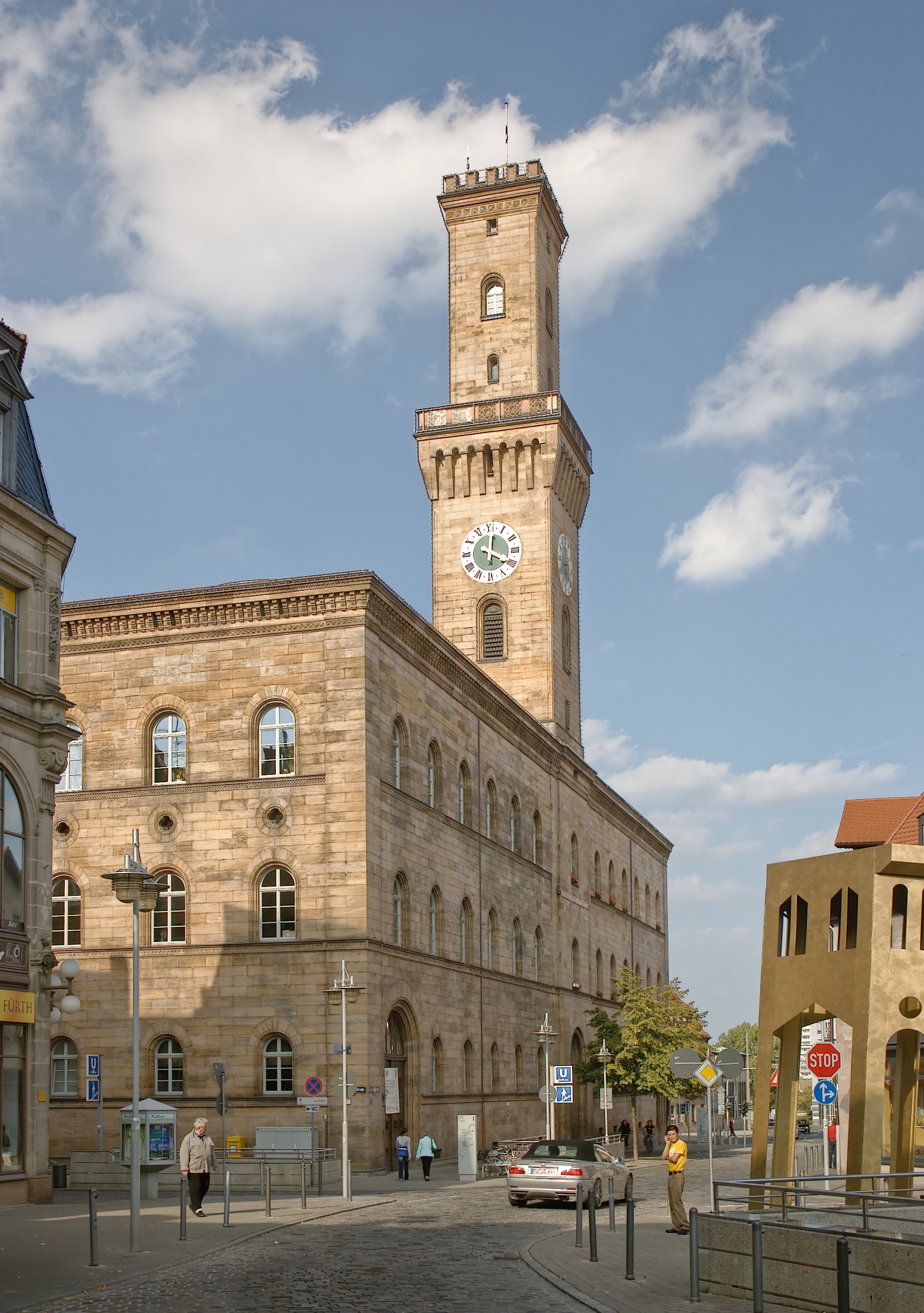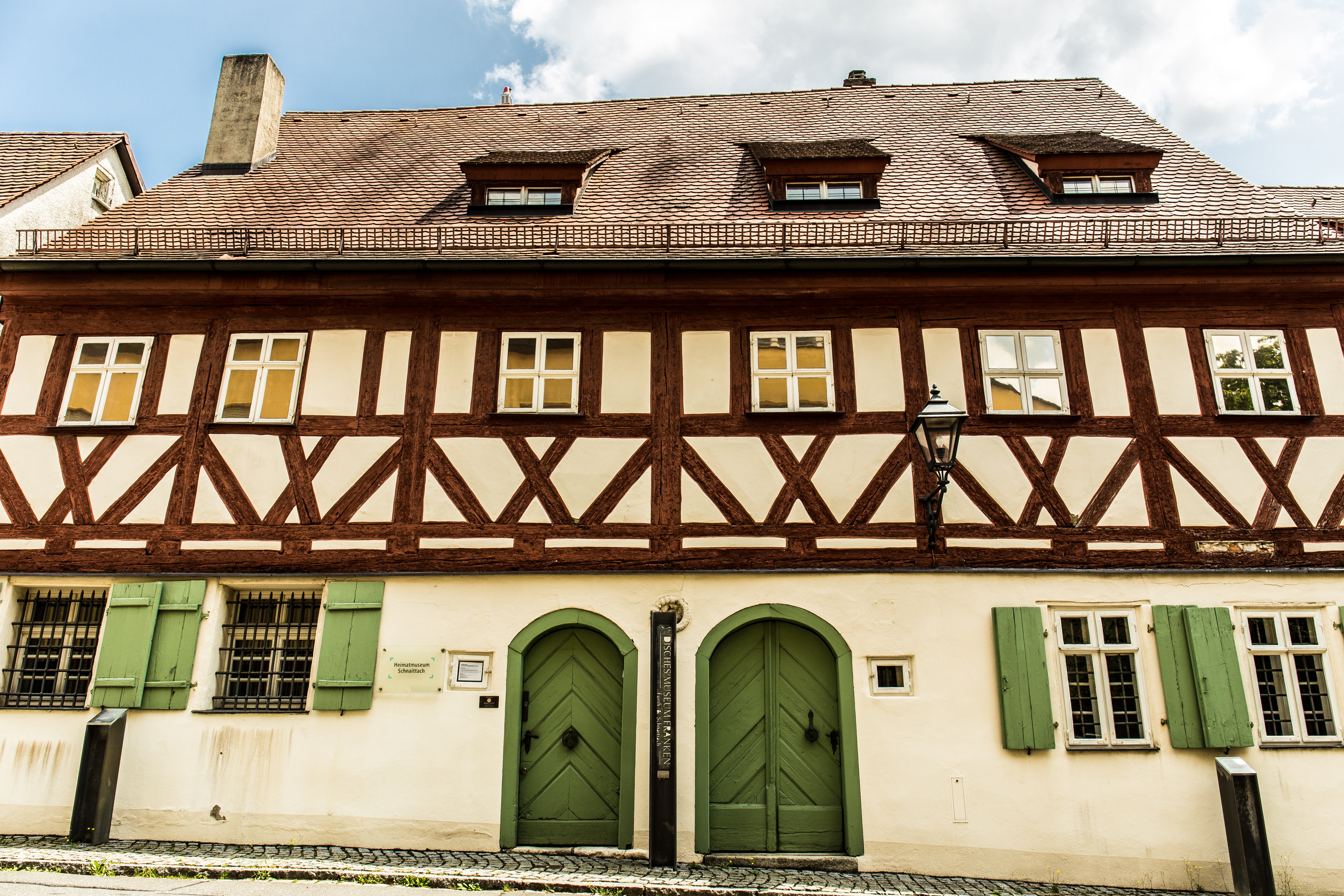|
Kalchreuth
Kalchreuth is a municipality in the district of Erlangen-Höchstadt, in Bavaria, Germany. It is located 10 kilometers east of Erlangen and 15 kilometers north of Nuremberg and contains the villages of Kalchreuth, Käswasser and Röckenhof and also the hamlets of Stettenberg, Minderleinsmühle and Gabermühle. History Like all Bavarian communities the municipality of Kalchreuth was founded in 1978 due to the Bavarian territorial reform. Yet, the first settlers came into the region between 1050 and 1100 A.D. and the village was first mentioned in a document in 1298. In 1342 most of the estates were sold to the Patrician family Haller von Hallerstein in whose possession it was until 1465 and was later on taken over by the Free Imperial City of Nuremberg. Because of being part of Nuremberg Kalchreuth got Prussian in 1796. Due to the Treaties of Tilsit the region got under French administration as being part of the Principality of Bayreuth from 1807 until 1810, after which it got p ... [...More Info...] [...Related Items...] OR: [Wikipedia] [Google] [Baidu] |
Heroldsberg
Heroldsberg (East Franconian: ''Herldsbärch'') is a municipality in the district of Erlangen-Höchstadt, in Bavaria, Germany. It is located eleven kilometers north-east from the city of Nuremberg and 23 kilometers east from Erlangen and is the headquarters of Schwan-Stabilo. Geography Location It is in the Sebalder Reichswald, the forest north to Nuremberg and is on a ridge. The Gründlach, a side river of the Regnitz, flows through the village of Heroldsberg. Municipality It contains Großgeschaidt, Kleingeschaidt and the villages of Heroldsberg, consisting of Heroldsberg, Johannisthal and Hundsmühle. Surrounding Municipalities It is surrounded by Eckental, Lauf an der Pegnitz, Nuremberg and Kalchreuth. History Heroldsberg's history goes back to the 11th century but it was first mentioned in 1225. Later on in 1387 the territory was sold to the Nuremberg patrician family ''Geuder'' in whose possession the lordship of Heroldsberg was for over 400 years, rendering them ''i ... [...More Info...] [...Related Items...] OR: [Wikipedia] [Google] [Baidu] |
Erlangen
Erlangen (; East Franconian German, East Franconian: ''Erlang'', Bavarian language, Bavarian: ''Erlanga'') is a Middle Franconian city in Bavaria, Germany. It is the seat of the administrative district Erlangen-Höchstadt (former administrative district Erlangen), and with 116,062 inhabitants (as of 30 March 2022), it is the smallest of the eight major cities (''Town#Germany, Großstadt'') in Bavaria. The number of inhabitants exceeded the threshold of 100,000 in 1974, making Erlangen a major city according to the statistical definition officially used in Germany. Together with Nuremberg, Fürth, and Schwabach, Erlangen forms one of the three metropolises in Bavaria. With the surrounding area, these cities form the Nuremberg Metropolitan Region, European Metropolitan Region of Nuremberg, one of 11 metropolitan areas in Germany. The cities of Nuremberg, Fürth, and Erlangen also form a triangle on a map, which represents the heartland of the Nuremberg conurbation. An element of th ... [...More Info...] [...Related Items...] OR: [Wikipedia] [Google] [Baidu] |
Eckental
Eckental is a municipality in the district of Erlangen-Höchstadt, in Bavaria, Germany. It is situated 14 km east of Erlangen, and 16 km northeast of Nuremberg. It contains 17 districts: Benzendorf, Brand, Brandermühle, Büg, Ebach, Eckenhaid, Eckenmühle, Eschenau, Forth, Frohnhof, Herpersdorf, Illhof, Marquardsburg, Mausgesees, Oberschöllenbach, Oedhof, and Unterschöllenbach. History In 1972, the Bavarian government reduced its number of communities from 7,010 to 2,056. This forged together the market town Eschenau and the formerly independent communes Forth, Eckenhaid, Herpersdorf, Benzendorf, Oberschöllenbach, Unterschöllenbach, and parts of Pettensiedel under the newly invented name of Eckental. It was the same year that its coat of arms was designed. In 1978, the village Brand joined the administrative union. The individual villages were founded in the Middle Ages about in the middle of the 11th and 12th century. The romantic church ''St Bartholomäus'' in ... [...More Info...] [...Related Items...] OR: [Wikipedia] [Google] [Baidu] |
Erlangen-Höchstadt
Erlangen-Höchstadt is a ''Landkreis'' (district) in Bavaria, Germany. It is bounded by (from the south and clockwise) the districts of Fürth, Neustadt (Aisch)-Bad Windsheim, Bamberg, Forchheim and Nürnberger Land, and by the cities of Nuremberg and Erlangen. The city of Erlangen is not part of the district, but nonetheless its administrative seat. History 300px, Waterwheel in the Regnitz near Möhrendorf. The earliest extant documents are drawings from 1413 which show water wheels along the Regnitz. The first (1449–1450) and second (1552–1555) Margrave wars, Brandenburg versus Nuremberg, devastated the countryside. In 1715 a lock was placed in the Regnitz river at Hemhofen. The highpoint of waterwheel usage was in the early 19th century when more than 190 were in use between Fuerth and Forchheim. The district was established in 1972 by merging the former districts of Erlangen and Höchstadt. Geography The main river is the Regnitz, which runs through the city of Er ... [...More Info...] [...Related Items...] OR: [Wikipedia] [Google] [Baidu] |
Bayerisches Landesamt Für Statistik
The statistical offices of the German states (German language, German: ''Statistische Landesämter'') carry out the task of collecting official statistics in Germany together and in cooperation with the Federal Statistical Office of Germany, Federal Statistical Office. The implementation of statistics according to Article 83 of the Basic Law for the Federal Republic of Germany, constitution is executed at state level. The Bundestag, federal government has, under Article 73 (1) 11. of the constitution, the exclusive legislation for the "statistics for federal purposes." There are 14 statistical offices for the States of Germany, 16 states: See also * Federal Statistical Office of Germany References {{Reflist National statistical services, Germany Lists of organisations based in Germany, Statistical offices Official statistics, Germany ... [...More Info...] [...Related Items...] OR: [Wikipedia] [Google] [Baidu] |
La Chapelle-des-Fougeretz
La Chapelle-des-Fougeretz () is a commune in the Ille-et-Vilaine department of Brittany in north-western France. Population Inhabitants of La Chapelle-des-Fougeretz are called in French ''chapellois''. See also *Communes of the Ille-et-Vilaine department The following is a list of the 333 Communes of France, communes of the Ille-et-Vilaine Departments of France, department of France. The communes cooperate in the following Communes of France#Intercommunality, intercommunalities (as of 2020): References External links *Mayors of Ille-et-Vilaine Association Communes of Ille-et-Vilaine {{IlleVilaine-geo-stub ... [...More Info...] [...Related Items...] OR: [Wikipedia] [Google] [Baidu] |
Fürth
Fürth (; East Franconian: ; yi, פיורדא, Fiurda) is a city in northern Bavaria, Germany, in the administrative division (''Regierungsbezirk'') of Middle Franconia. It is now contiguous with the larger city of Nuremberg, the centres of the two cities being only apart. Fürth is one of 23 "major centres" in Bavaria. Fürth, Nuremberg, Erlangen and some smaller towns form the "Middle Franconian Conurbation", which is one of the 11 German metropolitan regions. Fürth celebrated its thousand year anniversary in 2007, its first mention being on 1 November 1007. Geography The historic centre of the town is to the east and south of the rivers Rednitz and Pegnitz, which join to form the Regnitz to the northwest of the Old Town. To the west of the town, on the far side of the Main-Danube Canal, is the Fürth municipal forest (''Fürther Stadtwald''). To the east of Fürth, at roughly the same latitude, lies Nuremberg, and to the north is the fertile market-gardening area know ... [...More Info...] [...Related Items...] OR: [Wikipedia] [Google] [Baidu] |
Lauf An Der Pegnitz
Lauf an der Pegnitz (; Northern Bavarian: ''Lauf an da Pegnitz'') is a town to the East of Nuremberg, Germany. It is the capital of the district Nürnberger Land, in Bavaria. It is in the valley of the River Pegnitz, which flows through the town. In 2009, the municipality developed a climate protection plan which was supported by the German Ministry for the Environment. Twin towns – sister cities Lauf an der Pegnitz is twinned with: * Brive-la-Gaillarde, France * Drama, Greece * Nyköping, Sweden * Tirschenreuth, Germany Notable people *Hermann Roesler (1834–1894), economist *Martin Lauer (1937–2019), athlete, Olympic medalist, lived here *Martin Jellinghaus (born 1944), athlete, Olympic medalist * Marlene Mortler (born 1955), politician (CSU), Member of the Bundestag (2002–2019), Member of the European Parliament *Timo Rost Timo Rost (born 29 August 1978) is a German football manager and former player who last managed Erzgebirge Aue. Coaching career Rost took ov ... [...More Info...] [...Related Items...] OR: [Wikipedia] [Google] [Baidu] |
Hersbruck
Hersbruck () is a small town in Middle Franconia, Bavaria, Germany, belonging to the district Nürnberger Land. It is best known for the late-gothic artwork of the Hersbruck altar, the "Hirtenmuseum" and the landscape of Hersbruck Switzerland. History Hersbruck was founded in 976 when a castle was built there near a bridge. The name probably comes from ''Haderihesprucga'', the bridge of Haderich. In the Middle Ages the town was situated on the Golden Route from Nuremberg to Prague, which brought prosperity to Hersbruck. In 1297 Hersbruck was given municipal rights, after 1504 the town belonged to the area of the free imperial town Nuremberg and in 1806 became Bavarian. Hersbruck was the birthplace, in 1673, of Jacob Paul von Gundling, the famous and unfortunate historian at the court of Brandenburg-Prussia. During the Nazi regime, Hersbruck contained a subsidiary camp of Flossenbürg concentration camp. The camp had about 10,000 prisoners, about 4,000 of them died in Hersbruck. ... [...More Info...] [...Related Items...] OR: [Wikipedia] [Google] [Baidu] |
Schnaittach
Schnaittach is a market town in Middle Franconia, Bavaria, Germany. Geography Schnaittach is on the river Schnaittach, a tributary of the Pegnitz. History Schnaittach was first mentioned in 1011. Until 1806 the Christian population of Schnaittach was Catholic, in contrast to the surrounding areas. Schnaittach has had a large Jewish community since the 15th century. Today, the building complex of the synagogue houses a branch of the Jewish Museum of Franconia (the main museum is in Fürth). Twin towns * Twinned with Frohnleiten, Austria * "Friendship" with Schlettau Schlettau is a town in the district of Erzgebirgskreis, in Saxony in Germany. It is situated in the Ore Mountains (Germany), Ore Mountains, 5 km southwest of Annaberg-Buchholz, and 12 km east of Schwarzenberg, Saxony, Schwarzenberg. ..., Saxony References External links Official town Web site Fortifications near Schnaittach Jewish Museum of Franconia {{Authority control Nürnberger La ... [...More Info...] [...Related Items...] OR: [Wikipedia] [Google] [Baidu] |
Gräfenberg, Bavaria
Gräfenberg is a Franconian town in the district of Forchheim, in Bavaria, Germany. It is situated 16km southeast of Forchheim and 25km northeast of Nuremberg. Location Gräfenberg is located in the southern part of Little Switzerland. The town is characterised by a great range of elevation (from 400 to 550 metres). A brook, the Kalkach, flows through the town with a steep drop. Gräfenberg is divided into 16 districts: *The town Gräfenberg *Lilling *Hohenschwärz *Kasberg *Walkersbrunn *Dörnhof *Thuisbrunn *Höfles *Sollenberg *Rangen *Haidhof *Schlichenreuth *Guttenburg *Neusles *Lillinger Höhe *Gräfenberger Hüll Pictures Image:Stadtkirche-Rathaus-Gräfenberg-16-05-2005.jpeg, Town church and town hall image:Kriegerdenkmal-Gräfenberg-16-05-2005.jpeg, Memorial for the fallen of World War I and II above the town. Image:Gräfenberg Panorama 01.jpg, A panorama of the center and eastern part of Gräfenberg. Religion Gräfenberg is a majority Protestant town; even so, some ... [...More Info...] [...Related Items...] OR: [Wikipedia] [Google] [Baidu] |
Neunkirchen Am Brand
Neunkirchen am Brand is a municipality in the district of Forchheim in Bavaria in Germany. History Important dates are the founding of the Canons Regular of Saint Augustine monastery, Neunkirchen am Brand monastery, in 1314 and the conferment of the status as market town in 1410. In 1803 Neunkirchen along with the Prince-Bishopric of Bamberg became part of Bavaria. Between 1886 and 1963 Neunkirchen was located near a train route from Erlangen to Eschenau. After the Second World War, refugees settled in Neunkirchen and after the establishment of Siemens AG in Erlangen the town experienced a dramatic increase in inhabitants. Numerous suburbs were built around the traditional center of the town. Neunkirchen is also the home of a number of industrial and trade companies. The largest industrial employer is the axles factory, the ''Neunkirchener Achsenfabrik (NAF)''. Districts There are the following districts (pop. statistics as of December 31, 2006): * Neunkirchen (5995 inhabitan ... [...More Info...] [...Related Items...] OR: [Wikipedia] [Google] [Baidu] |


